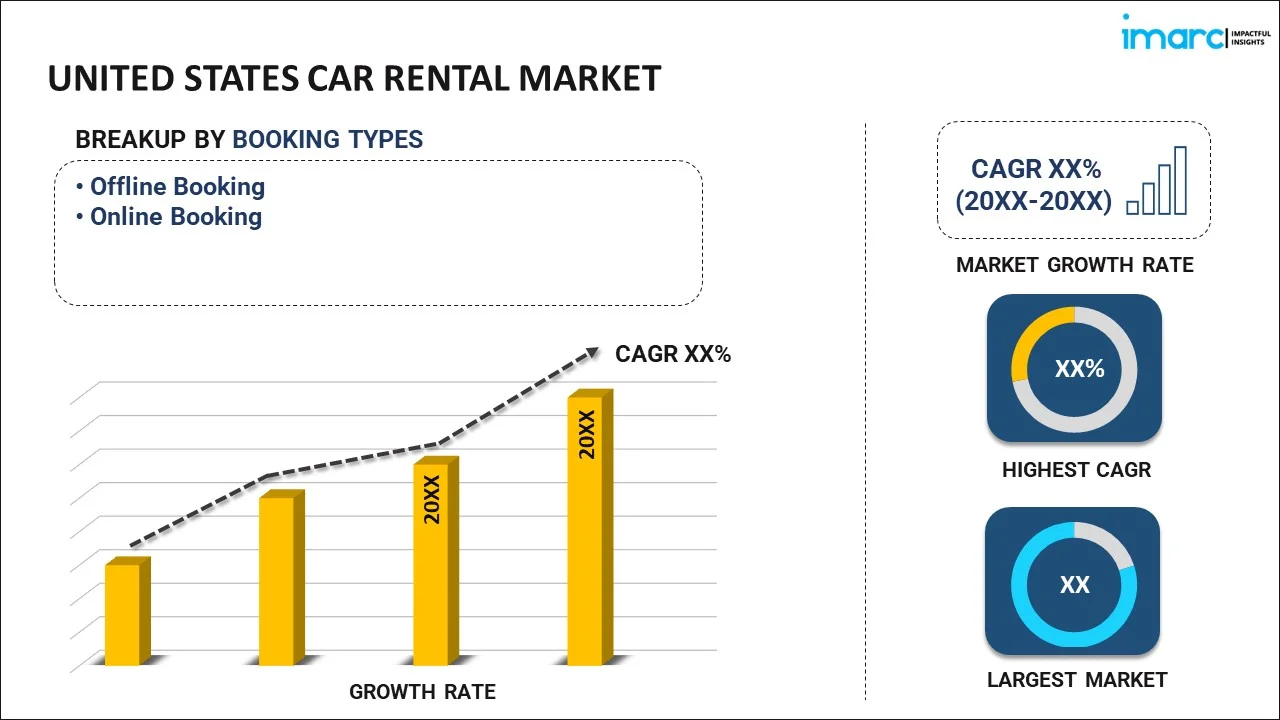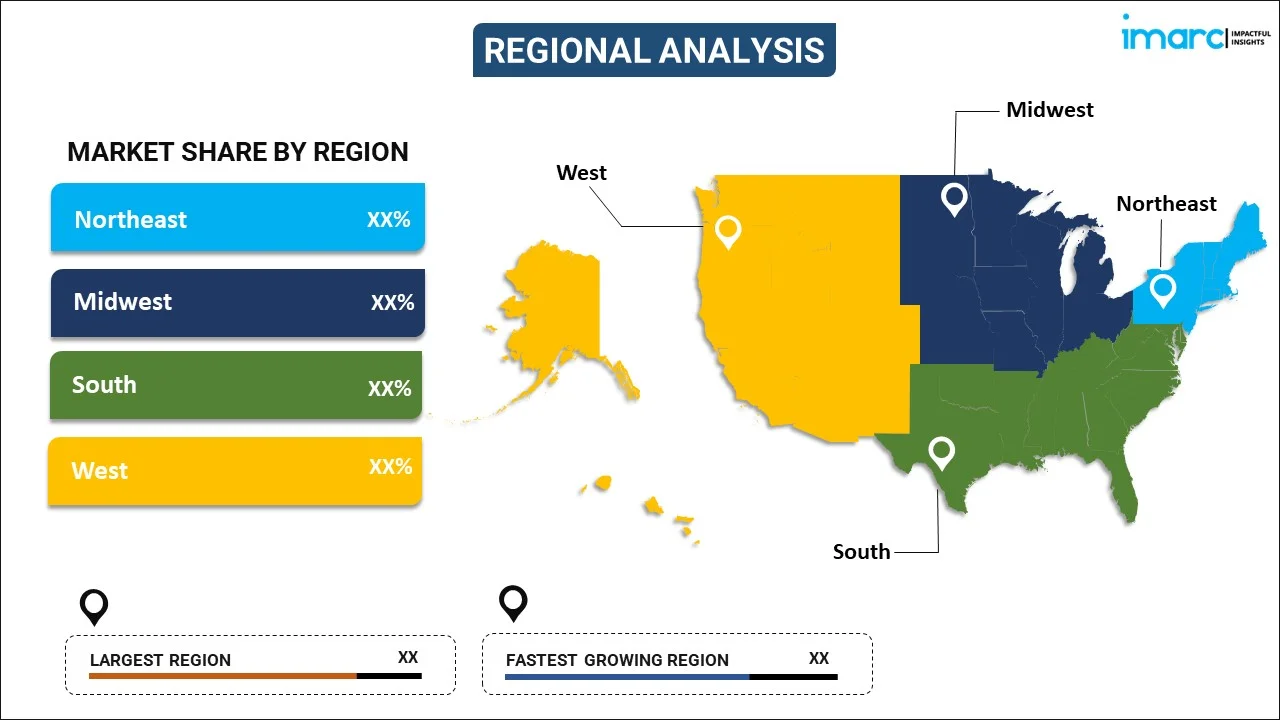IMARC made the whole process easy. Everyone I spoke with via email was polite, easy to deal with, kept their promises regarding delivery timelines and were solutions focused. From my first contact, I was grateful for the professionalism shown by the whole IMARC team. I recommend IMARC to all that need timely, affordable information and advice. My experience with IMARC was excellent and I can not fault it.
Read More
United States Car Rental Market Report by Booking Type (Offline Booking, Online Booking), Rental Length (Short Term, Long Term), Vehicle Type (Luxury, Executive, Economy, SUVs, and Others), Application (Leisure/Tourism, Business), End-User (Self-Driven, Chauffeur-Driven), and Region 2024-2032
Market Overview:
The United States car rental market size is projected to exhibit a growth rate (CAGR) of 8.01% during 2024-2032. Changing consumer preferences, strong disposable income levels, rising technological integration, fleet diversity and upgrades, an increasing number of business and corporate travel, and expanding travel and tourism industry represent some of the key factors driving the market.
|
Report Attribute
|
Key Statistics
|
|---|---|
|
Base Year
|
2023
|
|
Forecast Years
|
2024-2032
|
|
Historical Years
|
2018-2023
|
| Market Growth Rate 2024-2032 | 8.01% |
Car rental refers to the service provided by companies that allow individuals to temporarily lease vehicles for a specified period, typically ranging from a few hours to several days. This service offers convenience and flexibility for individuals who require transportation without the commitment and ownership associated with purchasing a vehicle. Customers can select from a range of vehicle types, such as sedans, SUVs, vans, or even luxury cars, based on their specific needs and preferences. Car rental agencies provide these vehicles for various purposes, including travel, business trips, vacations, or temporary transportation when a personal vehicle is unavailable. Car rental agreements typically involve a rental fee, which covers the cost of using the vehicle for the chosen duration, often accompanied by additional charges for mileage, insurance, fuel, and optional extras such as GPS devices or child seats. The convenience of renting a car allows individuals to access vehicles in various locations, whether at airports, city centers, or local branches of rental companies. Car rental services cater to a diverse customer base seeking various mobility solutions without the commitment and costs associated with vehicle ownership.
United States Car Rental Market Trends:
The expanding travel and tourism industry represents one of the key factors driving the growth of the market across the United States. As domestic and international travelers seek convenient and flexible transportation options, car rentals offer the flexibility to explore destinations at one's own pace. Whether for leisure or business travel, the demand for rental vehicles remains robust, which is contributing to consistent market growth. Consumer preferences are shifting toward experiences over ownership, especially among younger generations. Millennial and Gen Z travelers prioritize access to transportation rather than owning a car, which is acting as a major growth-inducing factor. Car rentals align with this trend, providing on-demand mobility without the long-term financial commitment of vehicle ownership. The corporate travel sector heavily relies on car rental services for employee mobility during business trips. Companies opt for car rentals as a cost-effective and efficient means of transportation, which is avoiding the maintenance and operational expenses associated with a dedicated fleet. The proximity of car rental services to airports plays a pivotal role in market growth. As airports remain major entry points for travelers, the convenience of renting a car immediately upon arrival is a driving factor. Rental companies strategically position themselves at airports to cater to this demand. Technological advancements are fueling the growth of the market. Online booking platforms and mobile apps facilitate seamless reservations, vehicle selection, and check-in processes. In addition to this, GPS navigation, digital contracts, and contactless payment options enhance the overall customer experience and are attracting tech-savvy consumers, which is creating a positive outlook for the market across the country.
United States Car Rental Market Segmentation:
IMARC Group provides an analysis of the key trends in each segment of the United States car rental market report, along with forecasts at the country level for 2024-2032. Our report has categorized the market based on booking type, rental length, vehicle type, application, and end-user.
Booking Type Insights:

- Offline Booking
- Online Booking
The report has provided a detailed breakup and analysis of the market based on the booking type. This includes offline and online booking.
Rental Length Insights:
- Short Term
- Long Term
A detailed breakup and analysis of the market based on the rental length has also been provided in the report. This includes short term and long term.
Vehicle Type Insights:
- Luxury
- Executive
- Economy
- SUVs
- Others
A detailed breakup and analysis of the market based on the vehicle type has also been provided in the report. This includes luxury, executive, economy, SUVs, and others.
Application Insights:
- Leisure/Tourism
- Business
A detailed breakup and analysis of the market based on the application has also been provided in the report. This includes leisure/tourism and business.
End-User Insights:
- Self-Driven
- Chauffeur-Driven
A detailed breakup and analysis of the market based on the end-user has also been provided in the report. This includes self-driven and chauffeur-driven.
Regional Insights:

- Northeast
- Midwest
- South
- West
The report has also provided a comprehensive analysis of all the major regional markets, which include the Northeast, Midwest, South, and West.
Competitive Landscape:
The report has also provided a comprehensive analysis of the competitive landscape in the United States car rental market. Competitive analysis such as market structure, key player positioning, top winning strategies, competitive dashboard, and company evaluation quadrant has been covered in the report. Also, detailed profiles of all major companies have been provided.
United States Car Rental Report Coverage:
| Report Features | Details |
|---|---|
| Base Year of the Analysis | 2023 |
| Historical Period | 2018-2023 |
| Forecast Period | 2024-2032 |
| Units | US$ Billion |
| Scope of the Report | Exploration of Historical and Forecast Trends, Industry Catalysts and Challenges, Segment-Wise Historical and Predictive Market Assessment:
|
| Booking Types Covered | Offline Booking, Online Booking |
| Rental Length Covered | Short Term, Long Term |
| Vehicle Types Covered | Luxury, Executive, Economy, SUVs, Others |
| Applications Covered | Leisure/Tourism, Business |
| End-Users Covered | Self-Driven, Chauffeur-Driven |
| Regions Covered | Northeast, Midwest, South, West |
| Customization Scope | 10% Free Customization |
| Report Price and Purchase Option | Single User License: US$ 3699 Five User License: US$ 4699 Corporate License: US$ 5699 |
| Post-Sale Analyst Support | 10-12 Weeks |
| Delivery Format | PDF and Excel through Email (We can also provide the editable version of the report in PPT/Word format on special request) |
Key Questions Answered in This Report:
- How has the United States car rental market performed so far and how will it perform in the coming years?
- What has been the impact of COVID-19 on the United States car rental market?
- What is the breakup of the United States car rental market on the basis of booking type?
- What is the breakup of the United States car rental market on the basis of rental length?
- What is the breakup of the United States car rental market on the basis of vehicle type?
- What is the breakup of the United States car rental market on the basis of application?
- What is the breakup of the United States car rental market on the basis of end-user?
- What are the various stages in the value chain of the United States car rental market?
- What are the key driving factors and challenges in the United States car rental market?
- What is the structure of the United States car rental market and who are the key players?
- What is the degree of competition in the United States car rental market?
Key Benefits for Stakeholders:
- IMARC’s report offers a comprehensive quantitative analysis of various market segments, historical and current market trends, market forecasts, and dynamics of the United States car rental market from 2018-2032.
- The research study provides the latest information on the market drivers, challenges, and opportunities in the United States car rental market.
- Porter's five forces analysis assist stakeholders in assessing the impact of new entrants, competitive rivalry, supplier power, buyer power, and the threat of substitution. It helps stakeholders to analyze the level of competition within the United States car rental industry and its attractiveness.
- Competitive landscape allows stakeholders to understand their competitive environment and provides an insight into the current positions of key players in the market.
Need more help?
- Speak to our experienced analysts for insights on the current market scenarios.
- Include additional segments and countries to customize the report as per your requirement.
- Gain an unparalleled competitive advantage in your domain by understanding how to utilize the report and positively impacting your operations and revenue.
- For further assistance, please connect with our analysts.

Purchase Options
Benefits of Customization
Personalize this research
Triangulate with your data
Get data as per your format and definition
Gain a deeper dive into a specific application, geography, customer, or competitor
Any level of personalization
Get in Touch With Us
UNITED STATES
Phone: +1-631-791-1145
INDIA
Phone: +91-120-433-0800
UNITED KINGDOM
Phone: +44-753-714-6104
Email: sales@imarcgroup.com
 Inquire Before Buying
Inquire Before Buying Speak to an Analyst
Speak to an Analyst  Request Brochure
Request Brochure  Request Customization
Request Customization



.webp)




.webp)












